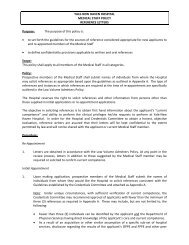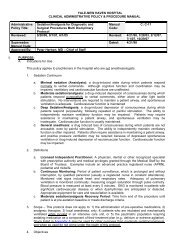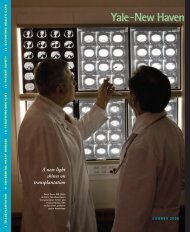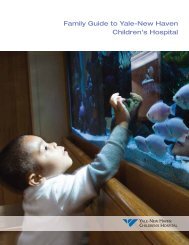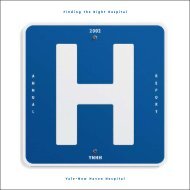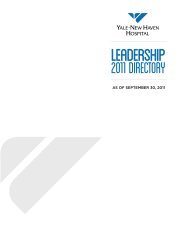What to Expect After a Cesarean Section
What to Expect After a Cesarean Section
What to Expect After a Cesarean Section
Create successful ePaper yourself
Turn your PDF publications into a flip-book with our unique Google optimized e-Paper software.
English <strong>What</strong> <strong>to</strong> <strong>Expect</strong> <strong>After</strong> a <strong>Cesarean</strong> <strong>Section</strong><br />
<strong>What</strong> <strong>to</strong> <strong>Expect</strong> <strong>After</strong> a<br />
<strong>Cesarean</strong> <strong>Section</strong> (C-section)<br />
Activity<br />
<strong>After</strong> a cesarean section you will be<br />
transferred <strong>to</strong> the Post Anesthesia Care<br />
Unit (Recovery Room). You will stay there<br />
for 2-3 hours after the procedure or until<br />
you can move your legs and are able <strong>to</strong><br />
move from the stretcher <strong>to</strong> your bed in the<br />
post partum unit.<br />
Breastfeeding<br />
You can breastfeed anytime you want. If<br />
you are not up <strong>to</strong> breastfeeding while you<br />
are in the Recovery Room, place your baby<br />
skin <strong>to</strong> skin <strong>to</strong> promote bonding. Your milk<br />
should “come in” 2 <strong>to</strong> 4 days after delivery.<br />
Before your milk comes in, your breasts<br />
may feel soft. When the milk comes in, your<br />
breasts may feel full and hard.<br />
Colostrum is the “early milk” or yellow<br />
liquid that you can squeeze from your<br />
breasts after delivery. Colostrum is what<br />
your baby will drink during the first couple<br />
of days after birth, if you choose <strong>to</strong><br />
breastfeed. Colostrum has fat,<br />
carbohydrates, protein, antibodies and other<br />
special ingredients in it that help keep your<br />
baby healthy. The Post Partum Unit has a<br />
breastfeeding class every day at 9:30 a.m.<br />
They also have lactation specialists who can<br />
help you with breastfeeding concerns.<br />
Baby Care<br />
Your baby may stay with you while you are<br />
in the Recovery Room unless it is your care<br />
provider thinks it is necessary for the baby<br />
<strong>to</strong> go up <strong>to</strong> the nursery. Your baby will be<br />
weighed, bathed, measured and given<br />
medicines or vaccinations in the Well Baby<br />
Nursery after you are transferred <strong>to</strong> the<br />
Post Partum Unit.<br />
Fundal Checks and Fundal Pain<br />
The <strong>to</strong>p part of your uterus is called the<br />
Fundus. <strong>After</strong> the C-section, your fundus<br />
should start <strong>to</strong> become hard. A medication<br />
called Pi<strong>to</strong>cin will be added <strong>to</strong> your I.V. <strong>to</strong><br />
facilitate this. This helps control bleeding.<br />
Your nurse will push on your abdomen <strong>to</strong><br />
feel how soft or hard the fundus is. If it<br />
feels soft, your nurse will massage it <strong>to</strong><br />
make it firm. This may be uncomfortable.<br />
Your fundus is checked often the first hour<br />
after delivery, and checked regularly after<br />
that. You may have “after pains” after<br />
giving birth. Contracting and relaxing of<br />
your uterus causes these pains. You may<br />
feel these pains for up <strong>to</strong> three days. The<br />
contractions get rid of the blood from<br />
inside the uterus and also help s<strong>to</strong>p<br />
bleeding. These contractions may be<br />
stronger and hurt more while you<br />
breastfeed your baby. Medications will be<br />
available <strong>to</strong> help with this pain.<br />
Foley Catheter<br />
A Foley catheter is a tube that is put in<strong>to</strong><br />
your bladder <strong>to</strong> drain urine after spinal<br />
anesthesia. This catheter is usually removed<br />
12-24 hours after the C-section.<br />
Diet<br />
You may be given ice chips/clear liquids at<br />
first. If you do not have problems after<br />
drinking liquids, your doc<strong>to</strong>r may change<br />
your diet <strong>to</strong> a regular diet.<br />
Bandages<br />
A bandage is used <strong>to</strong> cover your stitches or<br />
staples, keep area clean and dry, and help<br />
prevent infection. Your doc<strong>to</strong>r or resident<br />
will remove the dressing 24 hours after the<br />
C-section.<br />
F6218 Labor and Birth / Maternity R0510
English <strong>What</strong> <strong>to</strong> <strong>Expect</strong> <strong>After</strong> a <strong>Cesarean</strong> <strong>Section</strong><br />
Deep Breathing and Coughing<br />
This breathing exercise helps <strong>to</strong> keep you<br />
from getting a lung infection after surgery.<br />
Deep breathing opens the tubes going <strong>to</strong><br />
your lungs. Coughing helps <strong>to</strong> bring up<br />
sputum (mucus) from your lungs for you <strong>to</strong><br />
spit out. You should deep breathe and<br />
cough every hour while awake even if you<br />
wake up during the night.<br />
Hold a pillow tightly against your<br />
incision (cut) when you cough <strong>to</strong> help<br />
decrease the pain. Take a deep breath<br />
and hold the breath as long as you can.<br />
Then push the air out of your lungs<br />
with a deep, strong cough. Take 10<br />
deep breaths in a row every hour while<br />
awake. Remember <strong>to</strong> follow each deep<br />
breath with a cough.<br />
You may be asked <strong>to</strong> use an incentive<br />
spirometer. This helps you take deeper<br />
breaths. Put the plastic piece in<strong>to</strong> your<br />
mouth and take a very deep breath.<br />
Hold your breath as long as you can.<br />
Then let out your breath. Use your<br />
incentive spirometer 10 times in a row<br />
every hour while awake.<br />
Medicines<br />
Antibiotics: may be given <strong>to</strong> help treat<br />
or prevent infection caused by germs<br />
(bacteria).<br />
Anti-nausea medicine: may be given <strong>to</strong><br />
calm your s<strong>to</strong>mach and control<br />
vomiting. Pain medicine may upset<br />
your s<strong>to</strong>mach and make you feel like<br />
vomiting. Because of this, pain<br />
medicine and anti-nausea medicine are<br />
often given at the same time.<br />
Pain medicine: may be given <strong>to</strong> take<br />
away or decrease your pain. Medicine<br />
may be given regularly, or may only be<br />
given if you ask your nurses for it. Tell<br />
your nurses if your pain does not<br />
decrease enough for you <strong>to</strong> feel better.<br />
Do not wait until the pain is very bad <strong>to</strong><br />
ask for your pain medicine. If you wait<br />
<strong>to</strong>o long <strong>to</strong> take it, the medicine may not<br />
control your pain as well.<br />
Venodyne boots<br />
These are pressure cuffs that are connected<br />
<strong>to</strong> an air pump machine. The pump tightens<br />
and loosens different parts of the boots.<br />
This helps push the blood back <strong>to</strong> the heart<br />
<strong>to</strong> keep clots from forming.<br />
Bair Hugger<br />
<strong>After</strong> C-section, your body temperature is<br />
low due <strong>to</strong> the anesthesia medicines and the<br />
temperature in the Operating Room, the<br />
Bair Hugger is a warming blanket that is<br />
attached <strong>to</strong> a machine that forces warm air<br />
<strong>to</strong> the blanket.<br />
Vaginal Discharge<br />
You will have a vaginal discharge called<br />
“Lochia” after delivery. The Lochia is bright<br />
red the first one <strong>to</strong> two days after delivery,<br />
and later turns a pink color. The lochia<br />
changes <strong>to</strong> a white or yellow color by about<br />
the 10th day after delivery. How long you<br />
have lochia is different for each woman.<br />
Use a sanitary pad rather than a tampon.<br />
This help prevents vaginal infection. The<br />
lochia should not have a bad smell, if it<br />
does, you should contact your provider.<br />
Length of stay in the Hospital<br />
Mothers typically stay in the hospital for 3<br />
<strong>to</strong> 4 days after a C-section.<br />
Visiting Hours in Post Partum Units<br />
From 11:00 a.m. <strong>to</strong> 8:00 p.m.<br />
F6218 Labor and Birth / Maternity R0510


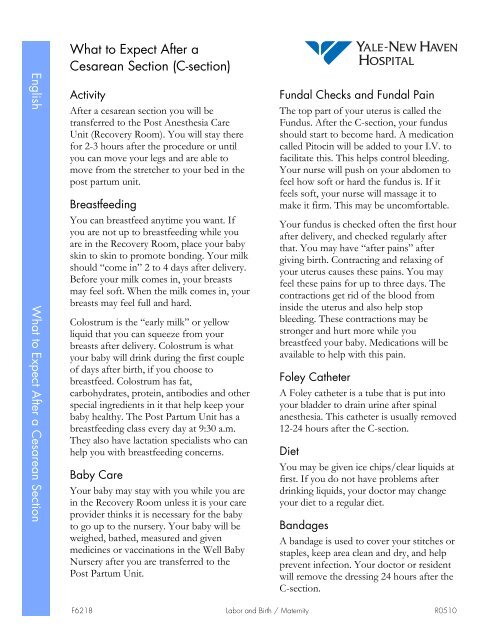



![Annual Report Donor Listings [pdf] - Yale-New Haven Hospital](https://img.yumpu.com/49673575/1/190x245/annual-report-donor-listings-pdf-yale-new-haven-hospital.jpg?quality=85)

